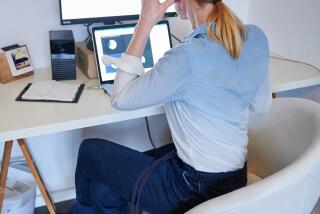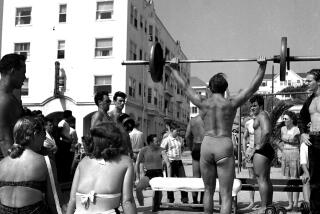Gain Without Pain Is Goal of Exercise to Lower Blood Pressure
Retired San Diego filmmaker Byron Skalman figures he’ll get back to combating his hypertension with regular exercise sometime after his visit to Minnesota this summer.
“I would prefer not to take drugs, and if I can discipline myself to exercise, then I think that would take care of my high blood pressure,” Skalman says.
For now, he’s trying to take short walks whenever he can--which isn’t very often.
But, far from being exercise expert John E. Martin’s nightmare, Skalman is this psychologist’s dream.
For it is in Skalman’s daily exercise dilemma that Martin finds inspiration for his work on finding ways to “psych” San Diegans into exercising for their own health.
“My belief is that we can take anybody and teach them to love exercise, if they follow the principles of learning carefully,” says Martin, a San Diego State University psychology professor.
The latest group targeted by Martin are people like Skalman--over age 65 and with high blood pressure requiring medication.
As part of federally funded experiment called Project HELPS, Martin is trying to find out if teaching 150 such people a habit of regular exercise will bring their blood pressure down, possibly even eliminating the need for medication.
“Medication can really mess with quality of life, especially in the elderly. They fall, they have side effects,” Martin said. “So we’d like to have them on a minimal dose, and we think quality of life is going to go up just with that.”
Skalman, 69, was a pilot patient in an abbreviated part of the study, and in three months last year he lowered his blood pressure from 160/88 to 142/72.
This put him into the study’s defined normal range, below 145/85. Skalman’s blood pressure has since risen again because other health problems have kept him from exercising, he said.
To get people to the point of exercising no matter what, Martin’s philosophy is to set a system of psychological rewards that make exercising something former couch potatoes want to do.
“Humans aren’t stupid. You develop enjoyment of exercise by enjoying yourself, by having it be rewarding, and by eliminating the punishing consequences,” he said.
“We must get rid of that myth of ‘No pain, no gain.’ That’s an absolute lie. The truth is that if you have pain when you’re exercising, you’re going to stop exercising,” he said.
Almost every American, if they live long enough, will develop hypertension, the most common cardiovascular disease. More than 60 million Americans have the condition, in which constricted arteries force the heart to pump harder to push blood through the body. Unless treated, this causes the heart to enlarge, lose efficiency and eventually can lead to stroke or heart attack.
Drugs often must be used against hypertension, but it is also known that lowering salt in the diet, losing weight and exercising regularly alleviate it.
Martin sees hypertension in the United States as largely “a disorder of life regulation.” Americans tend to do less and less physical activity as they age, a habit that is hard to break, he said.
“It takes a while to break that compulsion to just lay down and do nothing,” Martin said.
“I see being sedentary as an addiction,” he said. “Literally, people go through withdrawal when they try to break out of a sedentary lifestyle. They have aches and pains, maybe flu-like symptoms. It’s aversive. And as soon as they stop exercising it feels good. It’s the same negative reinforcement that we see in things like smoking and alcohol addiction.”
Tall and lean, Martin, 43, gets his own exercise by running several times a week, sometimes pushing his toddler son in a three-wheel stroller.
He says he came by his interest in exercise motivation the hard way, while in graduate school at Auburn University. As is often the pattern in the United States, he was a physically active child but had tapered off in young adulthood. He decided to take up running, since it could be done any time, anywhere.
“I went out and tried to run 10 miles with a friend and I hadn’t trained at all--and I got injured,” Martin said. “So I had to not do anything for a while and then gradually ‘shape’ my behavior up with a lot of the behavior-modification techniques that I had been learning.
“And I thought, ‘Well, if this works for me, maybe it’ll work for other people.’ ”
Working later at the VA Medical Center, in Jackson, Miss., Martin oversaw several studies to find out if it would. The answer was yes, but with some surprising twists.
For instance, unlike in breaking a habit such as smoking, setting daily goals doesn’t help. Daily goals actually discourage people from acquiring a long-term exercise habit, he found in a study of exercisers in Mississippi.
People also respond better to time goals than performance goals. Martin thinks this is because people with distance goals “overdid it to get the exercise done faster”--a negative reinforcement that discouraged them from exercising the next time.
So, rather than vowing to walk or run two miles, a new exerciser is better off saying, “I’ll walk/run for 15 minutes,” increasing the duration gradually over several weeks. As fitness increases, the distance will go up naturally, Martin said.
And, although true athletes seem to benefit from paying close attention to their bodies during a workout, the average Joe does best by distracting himself with music, thoughts or talking with friends.
Such details are especially important at the beginning of an exercise program, because establishing the exercise habit is paramount then, Martin said.
“There are some data that suggest that even if parking is inconvenient people will not continue to exercise. Even a little teeny barrier early in the development of the habit can block it,” he said.
But the most important way to reinforce it is by doing everything one can to make exercising easy and enjoyable. Martin calls it errorless, or continuous reinforcement, training.
“Every step of the way is enjoyable, is pleasurable, is rewarding, and we ensure that that’s so,” he said. “And the way that we ensure it is we have them do it at an easy level--what they’re capable of doing in terms of time and distance. We literally grab some people by the shoulders and say, ‘Slow down, enjoy it.’ ”
So, if someone new to exercise gets dressed for a workout, shows up and then quits after five minutes on an exercise bicycle, he still gets praised. The point is to be there.
“Our first goal in shaping is the habit. We want to set a real firm foundation of the habit, of showing up to exercise,” he said. It takes at least six months of regular working out before the exercise habit forms, he believes.
“When people take up exercising, the vast majority stop exercising after three to six months,” Martin said. As few as 5% may still be exercising after two years.
Martin thinks this is largely because traditional exercise programs emphasize performance too early. “They get the quick results, but they have a very weak foundation--the habit of exercise--and it falls, it crumbles.”
The SDSU hypertension study is called Project HELPS, for “Hypertension, Exercise and Lifestyle Program for Seniors.” Funded with a $1.7 million federal grant, it will use Martin’s reinforcement techniques to help 150 people between the ages of 65 and 85 address their hypertension through exercise.
Participants must have high blood pressure and no heart disease, and be willing to participate in group exercise sessions at SDSU for six months, plus monitoring for 18 months longer. A van can transport participants from and to home if necessary.
Martin estimates that about 1,000 people will have to be screened for researchers to find 150 who meet specific study criteria.
Even if they don’t make it past the testing phase, though, participants will have received about $1,000 worth of medical tests for free. These include an exercise stress test and weighing in water to determine body fat composition.
Martin and Masai Minters, a doctoral student in clinical psychology, would like to find as many minority-group participants for the study as possible. Blacks are particularly prone to hypertension, Minters noted.
“We don’t know much about, for instance, how to get Hispanics and blacks to exercise--what kind of cultural barriers there are,” Martin said. “So we’re really looking forward to delving into that.”
Potential participants can call the project, 594-7881, to volunteer.
Exercise-haters with normal blood pressure also will be able to benefit from Martin’s techniques through a new exercise promotion class that his program will offer through the extended studies program at SDSU. It will begin in summer or fall, and interested adults of all ages can call the SDSU extended studies office at 594-6255 for information, Martin said.


